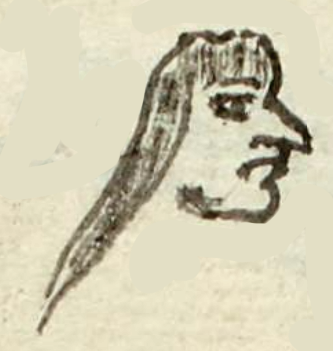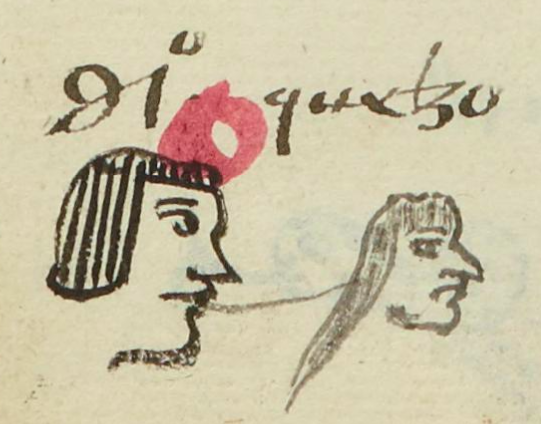Quetzon (MH833v)
This black-line drawing of the simplex glyph for the personal name Quetzon (“Long Hair,” attested here as a man’s name) shows a man's head in profile, facing toward the viewer's right. He has long hair (quetzontli) at the back of his neck. This hair was not drawn right onto the head of the tribute payer as can sometimes happen; an additional man's head was added that has this hair.
Stephanie Wood
The start to this name, Que-, seems to come from quechtli, throat or neck, which is then combined with tzontli, hair. Long hair on men could be associated with semi-sedentary Chichimecs and warriors. Sometimes priests had long hair. For more information on hair length, see Justyna Olko, Insignias of Rank in the Nahua World (2014), 35.The lock of hair called a tzontli was often bound with a leather strap and it acted as a kind of ponytail or top knot at the top of the head. This hairstyle can be found on priests and warriors. A bundle of hair called a tzontli could also stand for the number 400. Glyphs for this number can also look like grass or have a tree shape. See some examples below.
Stephanie Wood
dio quetzo
Diego Quetzon
Stephanie Wood
1560
Jeff Haskett-Wood
pelos, cabello, hair, hairstyles, heads, cabezas, nombres de hombres

quetzon(tli), hair long on the neck, https://nahuatl.wired-humanities.org/content/quetzontli
tzon(tli), hair or head, https://nahuatl.wired-humanities.org/content/tzontli
quech(tli), throat or neck, https://nahuatl.wired-humanities.org/content/quechtli
Cabello Largo
Stephanie Wood
Matrícula de Huexotzinco, folio 833r, World Digital Library, https://www.loc.gov/resource/gdcwdl.wdl_15282/?sp=741&st=image
This manuscript is hosted by the Library of Congress and the World Digital Library; used here with the Creative Commons, “Attribution-NonCommercial-ShareAlike 3.0 License” (CC-BY-NC-SAq 3.0).












